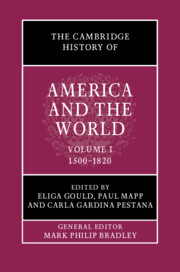Book contents
- The Cambridge History of America and the World
- The Cambridge History of America and the World
- The Cambridge History of America and the World
- Copyright page
- Contents
- Figures
- Maps
- Contributors to Volume I
- General Introduction: What is America and the World?
- Introduction: What Does America and the World “Mean” before 1825?
- Part I Geographies
- Part II People
- Part III Empires
- 9 The Early Iberian American World
- 10 Making Colonies and Empires in North America and the Greater Caribbean
- 11 Imperial Wars, Imperial Reforms
- 12 Law and Empire, 1500–1812
- Part IV Circulation/Connections
- Part V Institutions
- Part VI Revolutions
- Index
12 - Law and Empire, 1500–1812
from Part III - Empires
Published online by Cambridge University Press: 12 November 2021
- The Cambridge History of America and the World
- The Cambridge History of America and the World
- The Cambridge History of America and the World
- Copyright page
- Contents
- Figures
- Maps
- Contributors to Volume I
- General Introduction: What is America and the World?
- Introduction: What Does America and the World “Mean” before 1825?
- Part I Geographies
- Part II People
- Part III Empires
- 9 The Early Iberian American World
- 10 Making Colonies and Empires in North America and the Greater Caribbean
- 11 Imperial Wars, Imperial Reforms
- 12 Law and Empire, 1500–1812
- Part IV Circulation/Connections
- Part V Institutions
- Part VI Revolutions
- Index
Summary
When we think about law and empire, it is most accurate, if inelegant, to pluralize everything: empires, colonies, peoples, cultures, sources of law. The transnational turn has dramatic implications for the history of law in the Americas. Most obviously, especially for the period from 1500 to 1812, scholars have become increasingly sensitive to the role of European empires – including the British, French, and Spanish – in shaping America’s legal cultures. Groups of colonists from across Europe brought a multiplicity of understandings of law and social order with them, encountering Indigenous nations with their own rich legal traditions. Colonists used law to justify their wars, govern their settlements, and express their politics. They also used law to forge relationships with the polities around them, including Indigenous nations and rival colonies. During this period of legal superabundance, the questions of whose law, and what law, applied in colonial jurisdictions were always live, and often impossible to answer with certainty. Law changed as it traveled across oceans, plains, and mountains, incorporating local traditions here and obliterating them there, sometimes deliberately, sometimes by accident.
- Type
- Chapter
- Information
- The Cambridge History of America and the World , pp. 274 - 294Publisher: Cambridge University PressPrint publication year: 2022



